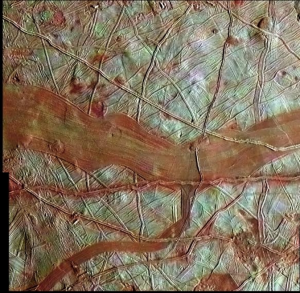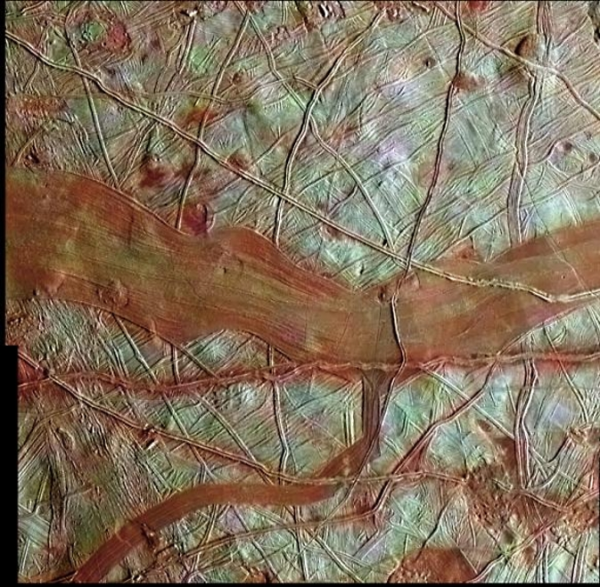 An upcoming mission to Europa may be the best chance for finding extra-terrestrial life in our solar system. In preparation for this historic mission, NASA is seeking proposals for the science instruments that could be carried aboard this future mission to one of Jupiter’s moons.
An upcoming mission to Europa may be the best chance for finding extra-terrestrial life in our solar system. In preparation for this historic mission, NASA is seeking proposals for the science instruments that could be carried aboard this future mission to one of Jupiter’s moons.
Formally referred to as an “Announcement of Opportunity (AO)” the request for proposals is seeking instruments could address fundamental questions about the icy moon and the search for life beyond Earth.
“The possibility of life on Europa is a motivating force for scientists and engineers around the world,” said John Grunsfeld, associate administrator for NASA’s Science Mission Directorate at the agency’s headquarters in Washington. “This solicitation will select instruments which may provide a big leap in our search to answer the question: are we alone in the universe?”

Compiled from NASA’s Galileo spacecraft data, this colorized surface image of Europa shows the blue-white terrains which indicate relatively pure water ice. Scientists are very interested in these features because they may offer a way to investigate the habitability of the moon’s interior ocean. Image Credit: NASA/JPL-Caltech/SETI Institute
From the proposals submitted, the agency will select approximately 20 this April, and then provide the selectees with approximately $25 million to advance instrument formulation and development as part of a Phase A concept study.
After this phase, the list will be narrowed down with the aim of selecting eight instruments to be built for flight and science operations, and their eventually journey to the icy surface of Europa.
Current belief among most scientists holds that beneath the frozen surface, Europa likely has a liquid ocean which may harbor life.
Proposals for the mission must be compatible with a spacecraft that would either orbit or perform multiple flybys of Europa. The instruments “will be used to conduct high priority scientific investigations addressing the science goals for the moon’s exploration outlined in the National Resource Council’s (NRC) Planetary Decadal Survey.”
The Decadal Survey deemed a mission to Europa among the highest priority scientific pursuits for NASA. It listed
A mission of high priority for NASA, the agency has identified five key science objectives in priority order that are necessary to improve our understanding of the potentially habitable moon:
•Characterize the extent of the ocean and its relation to the deeper interior
•Characterize the ice shell and any subsurface water, including their heterogeneity, and the nature of surface-ice-ocean exchange
•Determine global surface, compositions and chemistry, especially as related to habitability
•Understand the formation of surface features, including sites of recent or current activity, identify and characterize candidate sites for future detailed exploration
•Understand Europa’s space environment and interaction with the magnetosphere.
While characterizing landing sites for future exploration is the fourth scientific priority in the Planetary Decadal Survey, NASA places high priority on this goal to enable a potential future lander mission to Europa. Current data does not provide sufficient information to identify landing sites and design a landing system capable of safely reaching the surface. In the AO, NASA included a reconnaissance goal to characterize scientifically compelling sites, as well as hazards, for a potential future landed mission to Europa.
“Proposals must be responsive to one or more of the six objectives,” said Curt Niebur, Outer Planets Program scientist at NASA Headquarters in Washington. “Plans could be adjusted to programmatic decisions made by NASA in the future.”
The deadline for submitting proposals to the AO is October 17, 2014, and more information about the process and the mission can be found online by going to:
http://go.nasa.gov/1p1QU0b.
More information about Europa itself is available from NASA on its web site at: http://solarsystem.nasa.gov/europa.
![Herbal Reference Substances are Key to Everyday Products <!-- AddThis Sharing Buttons above -->
<div class="addthis_toolbox addthis_default_style " addthis:url='http://newstaar.com/herbal-reference-substances-are-key-to-everyday-products/3512112/' >
<a class="addthis_button_facebook_like" fb:like:layout="button_count"></a>
<a class="addthis_button_tweet"></a>
<a class="addthis_button_pinterest_pinit"></a>
<a class="addthis_counter addthis_pill_style"></a>
</div>When it comes to quality control testing and the development of new products, Botanical Reference Materials (BRMs), also known as Herbal References are critically important. To help companies ultimately obtain all-important FDA approval, the Food and Drug Administration provides in its guidance a recommendation that […]<!-- AddThis Sharing Buttons below -->
<div class="addthis_toolbox addthis_default_style addthis_32x32_style" addthis:url='http://newstaar.com/herbal-reference-substances-are-key-to-everyday-products/3512112/' >
<a class="addthis_button_preferred_1"></a>
<a class="addthis_button_preferred_2"></a>
<a class="addthis_button_preferred_3"></a>
<a class="addthis_button_preferred_4"></a>
<a class="addthis_button_compact"></a>
<a class="addthis_counter addthis_bubble_style"></a>
</div>](http://newstaar.com/wp-content/uploads/2021/02/Achillea_millefolium_flowers-100x100.jpg)
![Quality Electrochemical Biosensors are Critical for Medical, Food and Chemical Industry <!-- AddThis Sharing Buttons above -->
<div class="addthis_toolbox addthis_default_style " addthis:url='http://newstaar.com/quality-electrochemical-biosensors-are-critical-for-medical-food-and-chemical-industry/3512086/' >
<a class="addthis_button_facebook_like" fb:like:layout="button_count"></a>
<a class="addthis_button_tweet"></a>
<a class="addthis_button_pinterest_pinit"></a>
<a class="addthis_counter addthis_pill_style"></a>
</div>A number of industries have, at their core, a need to frequent or even continuous analysis of biological media. These include the medical and pharmaceutical fields, biotech firms, and food and chemical companies. To maintain quality standards and develop new products, these industries rely heavily […]<!-- AddThis Sharing Buttons below -->
<div class="addthis_toolbox addthis_default_style addthis_32x32_style" addthis:url='http://newstaar.com/quality-electrochemical-biosensors-are-critical-for-medical-food-and-chemical-industry/3512086/' >
<a class="addthis_button_preferred_1"></a>
<a class="addthis_button_preferred_2"></a>
<a class="addthis_button_preferred_3"></a>
<a class="addthis_button_preferred_4"></a>
<a class="addthis_button_compact"></a>
<a class="addthis_counter addthis_bubble_style"></a>
</div>](http://newstaar.com/wp-content/uploads/2020/10/Electrochemical-Biosensor-100x100.jpg)
![Company Develops Industrial Mixers Well-Suited for both Fragile and Explosive Products <!-- AddThis Sharing Buttons above -->
<div class="addthis_toolbox addthis_default_style " addthis:url='http://newstaar.com/company-develops-industrial-mixers-well-suited-for-both-fragile-and-explosive-products/3512071/' >
<a class="addthis_button_facebook_like" fb:like:layout="button_count"></a>
<a class="addthis_button_tweet"></a>
<a class="addthis_button_pinterest_pinit"></a>
<a class="addthis_counter addthis_pill_style"></a>
</div>Industrial drum mixers are normally applied to blend mixes of varying viscosities such as adhesive slurries or cement. Some of these mixers have the capability of blending mixes of very different particle sizes such as fruit and ice cream, and gravel and cement slurry. The […]<!-- AddThis Sharing Buttons below -->
<div class="addthis_toolbox addthis_default_style addthis_32x32_style" addthis:url='http://newstaar.com/company-develops-industrial-mixers-well-suited-for-both-fragile-and-explosive-products/3512071/' >
<a class="addthis_button_preferred_1"></a>
<a class="addthis_button_preferred_2"></a>
<a class="addthis_button_preferred_3"></a>
<a class="addthis_button_preferred_4"></a>
<a class="addthis_button_compact"></a>
<a class="addthis_counter addthis_bubble_style"></a>
</div>](http://newstaar.com/wp-content/uploads/2020/06/bandeau-sofragir2-100x100.jpg)